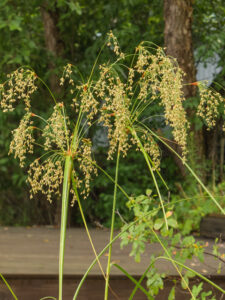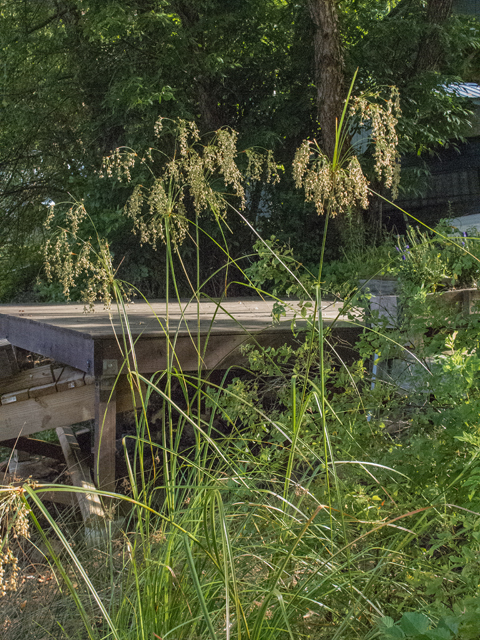Natives to Know: Woolgrass bulrush – Scirpus cyperinus
By Joyce Tuharsky, WORC Member

Woolgrass bulrush is a large, emergent aquatic plant that grows 6-feet-tall in colonies along lakes, marshes, and streams, and in wet meadows or low woodlands. Native to much of the eastern U.S., it spreads by creeping rhizomes or self-sowing in wet soils, including shallow standing water (up to 4 inches deep). Its fleecy growth makes an attractive addition to a winter garden.
Despite its name, Woolgrass bulrush is not a grass nor a rush, but a type of sedge. As the saying goes: “Sedges have edges” … and Woolgrass bulrush does have hard, dark green, triangular (in cross-section) stems. Five to 10 very long (3 foot) arching leaf blades grow from the base of the stems, with reddish-green leaf sheaths that glow in the sun.
In early summer, the widely-spaced, upright stems become topped by a spreading compound umbel made up of many spikelets with groups of florets at the tips—all branching and drooping, several inches long. While the flowers themselves are small and green, the overall structure of the inflorescence is striking, looking like small fireworks swaying in the breeze. And indeed, the florets are cross-pollinated by the wind.
By late summer, the florets mature into seeds (or nutlets) that are reddish brown with bristles that present an attractive soft woolly appearance. As fall approaches, the woolly inflorescences remain; and the plant’s foliage turns brown, gold, and burgundy, providing lovely interest well into winter.
Woolgrass bulrush is an important wetland species that provides food/shelter for birds and other wildlife.

Many species of ducks and other wetland birds feed on its seedheads, Trumpeter swans and Canada geese eat the foliage, and muskrats eat the rhizomes. Insects that feed on this plant include leaf beetles, weevils, aphids, and larvae of skippers and moths. The dense basal growth makes great nesting sites and cover for small animals.
Native Americans used this plant for many purposes. The Ojibwe used the long leaves to make baskets, mats, and bedding. The Potawatomi used the “wool” to stuff pillows.
In your landscape, Woolgrass bulrush can be used to spruce up the margins of streams/ponds; in rain/water gardens, wet woodlands, or low damp areas; or near a septic field. This plant prefers full to partial sun, wet to moist conditions (but tolerates occasional dry), and muddy or sandy soils. When planted en masse, it is good for erosion control, forming a buffer against wind and wave action, permitting other less resilient aquatic plants to grow. It is low maintenance, and deer resistant. Propagate by seed or root division in spring.
Photos: Stephanie Brundage, Wildflower Center Digital Library
Sources:
BONAP’s North American Plant Atlas (NAPA)
Gardenia.net
Illinoiswildflowers.info
Lady Bird Johnson Wildflower Center, Native Plants of North America (wildflower.org)
North Carolina Extension Gardener Plant Toolbox (ncsu.edu)
Plant Finder (missouribotanicalgarden.org)
